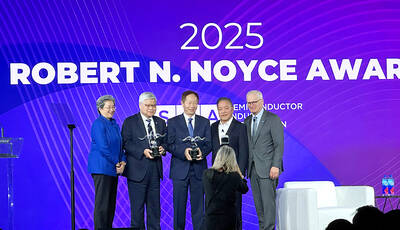Exports last month spiked 38.6 percent year-on-year to a new high of US$37.41 billion, driven by robust demand for all product categories by major countries that have been reopening their economies following progress in their vaccination drives, the Ministry of Finance said yesterday.
The increase this month might be 27 to 31 percent as the economic scene abroad looks bright, while a COVID-19 outbreak at home has had little effect on the nation’s manufacturing activity, the ministry said.
“Demand for electronics remains strong, aided by the global pursuit of new technologies, while non-tech products benefit from spending by major countries that aim to strengthen their infrastructure projects,” Department of Statistics Director-General Beatrice Tsai (蔡美娜) told an online news conference in Taipei.

Photo: CNA
A low comparison base last year also helped exports of non-tech products grow much faster than those of tech products, Tsai said.
Shipments of base metals and related products surged 54.2 percent year-on-year, while those of plastic and mineral products rose 74.7 percent and 117.3 percent respectively, she said.
Exports of transportation tools increased 58.4 percent, thanks to the growing popularity of bikes, as well as a recovery in the auto market, Tsai said.
Demand for electronics, as well as devices used in remote working and remote learning, continued to increase, she said.
Shipments of electronics products expanded 29.6 percent to US$13.27 billion, accounting for 35.5 percent of overall exports, the ministry said.
In particular, shipments of semiconductors grew 29.5 percent to US$11.93 billion, fueled by demand for new technologies, it said.
Imports rose 40.9 percent to US$31.25 billion, giving Taiwan a trade surplus of US$6.16 billion, a bump of 27.9 percent from May last year, the ministry said.
Imports of agricultural and industrial raw materials picked up 43.6 percent to US$211.83 billion, helped by price hikes, while capital equipment, a critical gauge of export needs, soared 36.5 percent, Tsai said.
Specifically, imports of semiconductor equipment picked up 46.3 percent as local tech firms aggressively acquired new equipment for technology upgrades and capacity expansion, she said, adding that chip shortages continued to plague critical sectors around the world.
Trading partners worldwide increased purchases of Taiwanese goods last month, but resurging COVID-19 outbreaks in Asia could weaken regional demand next quarter, Tsai said, citing Formosa Plastics Group (FPG, 台塑集團), Taiwan’s largest industrial conglomerate.
FPG is looking at flat sales or a mild decline in business next quarter from this quarter, as the virus outbreak weakens economic activity.
For the first five months of this year, the nation’s exports expanded 30.2 percent year-on-year to US$170.32 billion, while imports gained 26 percent to US$143.61 billion, ministry data showed.

Shiina Ito has had fewer Chinese customers at her Tokyo jewelry shop since Beijing issued a travel warning in the wake of a diplomatic spat, but she said she was not concerned. A souring of Tokyo-Beijing relations this month, following remarks by Japanese Prime Minister Sanae Takaichi about Taiwan, has fueled concerns about the impact on the ritzy boutiques, noodle joints and hotels where holidaymakers spend their cash. However, businesses in Tokyo largely shrugged off any anxiety. “Since there are fewer Chinese customers, it’s become a bit easier for Japanese shoppers to visit, so our sales haven’t really dropped,” Ito

The number of Taiwanese working in the US rose to a record high of 137,000 last year, driven largely by Taiwan Semiconductor Manufacturing Co’s (TSMC, 台積電) rapid overseas expansion, according to government data released yesterday. A total of 666,000 Taiwanese nationals were employed abroad last year, an increase of 45,000 from 2023 and the highest level since the COVID-19 pandemic, data from the Directorate-General of Budget, Accounting and Statistics (DGBAS) showed. Overseas employment had steadily increased between 2009 and 2019, peaking at 739,000, before plunging to 319,000 in 2021 amid US-China trade tensions, global supply chain shifts, reshoring by Taiwanese companies and

Taiwan Semiconductor Manufacturing Co (TSMC) Chairman C.C. Wei (魏哲家) and the company’s former chairman, Mark Liu (劉德音), both received the Robert N. Noyce Award -- the semiconductor industry’s highest honor -- in San Jose, California, on Thursday (local time). Speaking at the award event, Liu, who retired last year, expressed gratitude to his wife, his dissertation advisor at the University of California, Berkeley, his supervisors at AT&T Bell Laboratories -- where he worked on optical fiber communication systems before joining TSMC, TSMC partners, and industry colleagues. Liu said that working alongside TSMC

TECHNOLOGY DAY: The Taiwanese firm is also setting up a joint venture with Alphabet Inc on robots and plans to establish a firm in Japan to produce Model A EVs Manufacturing giant Hon Hai Precision Industry Co (鴻海精密) yesterday announced a collaboration with ChatGPT developer OpenAI to build next-generation artificial intelligence (AI) infrastructure and strengthen its local supply chain in the US to accelerate the deployment of advanced AI systems. Building such an infrastructure in the US is crucial for strengthening local supply chains and supporting the US in maintaining its leading position in the AI domain, Hon Hai said in a statement. Through the collaboration, OpenAI would share its insights into emerging hardware needs in the AI industry with Hon Hai to support the company’s design and development work, as well